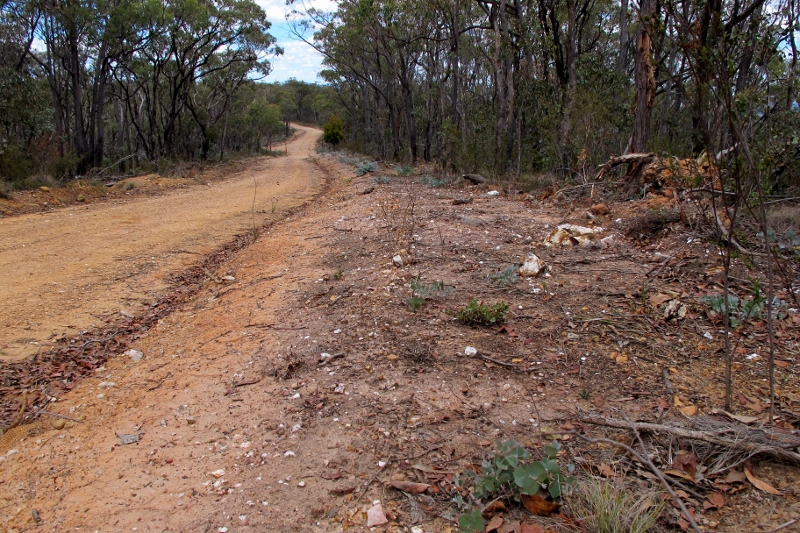Like many other groups, FOBIF has been invited to make a submission to the fire planning process this year. The substance of our submission is as follows:
Our views on fire management have not changed since our 2015 submission, the substance of which we have reproduced below. Our overarching concerns are:
1. We are concerned about the conduct of large area burns [see below], and would like some detailed information about the proposed ecological and safety objectives in these operations [for example, what exactly is the ecological objective in burning Gough’s Range?]

Fryers Ridge Road, February 2016: the grey foliage is Long Leaved Box regrowth. Last year’s roadside scalping has obliterated harmless groundcovers, but has led to proliferation of eucalypts which are likely to obscure sightlines within a few years. Better ways of controlling vegetation are available–and recommended.
2. We understand that a new burn has been added, in the Fryers Ranges. We would like more information on this.
3. We are more concerned than ever about track works in bushland. We understand that these are partly designed to improve access and safety for fire trucks: but would like to point out that view lines can be improved by other means than gouging the road verges. For example: we have noticed that last year’s work on the Fryers Ridge Road has obliterated harmless ground covers like Grevillea obtecta, but has resulted in a healthy regrowth of Long Leaved Box—a tree very likely to obstruct sightlines within a couple of years.
4. We are also concerned by the way DELWP constructs its mineral earth breaks—in some cases, seemingly in order to maximise erosion. We sincerely hope that fire operations can be kept within existing track lines.
5. We would like to know how the adoption of a Risk Landscape policy has changed approaches to fire management in our area. We would take a close interest in new burns devised under this policy.
6. We remain keenly interested in areas of high conservation value and social interest [for example, Kalimna Park].
******************
Here are relevant sections of our 2015 submission. Highlighted are matters of particular current concern:
General
We would like to know how the planned burning program on public land fits with the ‘priority fuel management areas’ referred to in last year’s West Central Risk Landscape management plan, and how it relates to fuel management in the adjacent ‘priority areas’ on private land.
We remain disturbed by the unavailability of burn plans and post burn assessments, in spite of the requirements explicitly set out in the Code of Practice.
We are particularly concerned about the relatively large area burns zoned LMZ [for example, in the Muckleford/Maldon areas], and would like to see the risk management assessments and specific ecological intentions in these burns.
Specific
We remain concerned over the Tarilta valley, Tarrengower, Taradale, Gough’s Range and Muckleford/Maldon burns. [see our 2014 submission]
For each of the above burns, we would like to know what monitoring and research has informed decision making about what values are to be protected in these areas.
We would like to know what specific risks DELWP has identified for the Castlemaine/Chewton area, and how the fuel management plan responds to these risks.
We believe that the Department should, as part of its risk assessment process, identify the numerous areas of flammable weeds close to settlements and roads, and employ the appropriate methods to reduce them—not necessarily by fire.
We remain concerned about the unaccountable number of large habitat trees brought down in even the patchiest of DELWP fires.
We are also concerned about the destructive track work which seems to accompany almost every fire.




 Click on image for info/order page
Click on image for info/order page Click on image for info/order page
Click on image for info/order page Click on image for info/order page
Click on image for info/order page





















There is some interesting analysis of prescribed burning in this article from the Tasmanian Times website:
http://tasmaniantimes.com/index.php?%2Farticle%2FZero-tolerance-of-fires-in-Australia-a-new-paradigm-for%2F